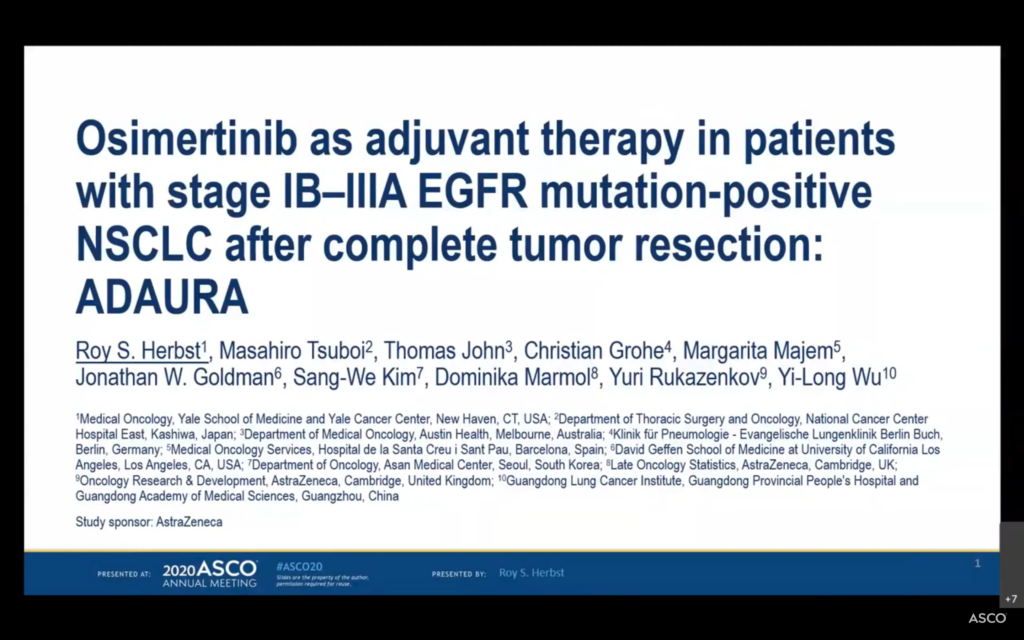
European Lung Cancer Conference 2016
Geneva – At the 2016 European Lung Cancer Conference (ELCC) today, one of the highlights to watch out for is the presentation of first-line data for AstraZeneca’s ($AZN) third generation EGFR inhibitor osimertinib (Tagrisso), formerly known as AZD9291.
At 3.30pm in Geneva (9.30am on the East Coast of the United States), Dr Suresh Ramalingam (Winship Cancer Institute, Emory) will present updated data from two expansion cohorts of the AURA phase 1 trial (NCT01802632) with updated results on the use of osimertinib in the first-line setting:
LBA1_PR: Osimertinib as first-line treatment for EGFR mutation-positive advanced NSCLC: updated efficacy and safety results from two Phase I expansion cohorts. S. Ramalingam, J.C.-H. Yang, C.K. Lee, T. Kurata, D.-W. Kim, T. John, N. Nogami, Y. Ohe, P.A. Jänne
Do follow tweets from the conference (#ELCC16).
As Dr Ramalingam noted in a press release issued by the European Society for Medical Oncology (ESMO):
“The overall response rate was among the best reported for first-line therapy of EGFR mutated NSCLC. The PFS results are exciting, well exceeding the historical control rates of 10 to 13 months with first or second generation drugs. Many of the patients have not had disease progression on the study and are still benefitting from treatment.”
Readers will recall osimertinib was approved by the FDA last November (link to press release) for the treatment of advanced non-small cell lung cancer (NSCLC) in patients who test positive for an epidermal growth factor receptor (EGFR) T790M mutation following prior treatment with an EGFR tyrosine kinase inhibitor (TKI).
Nearly two-thirds of patients who receive an EGFR-TKI develop a T790M mutation, and until the approval of osimertinib, there were no approved treatment options.
I vividly remember being in the audience at the European Cancer Congress in Amsterdam back in September 2013 and listening to Professor Malcolm Ranson (Christie, Manchester) present the first clinical data from the phase 1 study, which at that time was only a single center. See post: ECCO 2013: AZD9291 shows early promise in NSCLC.
Dr Ross Camidge (Denver), who was the discussant in Amsterdam, concluded his discussion with a picture of the first step on the moon. Cancer metaphors around the moon and moonshots have since become overused, but I think this one was justified at the time:
“By addressing acquired resistance at the molecular level potentially creating one small step in the EGFR treatment paradigm, third-generation inhibitors like 9291 are likely to represent one giant leap forward in the treatment of EGFR mutant disease.”
~ Dr Ross Camidge at ECC 2013.
Whatever the role we play in cancer drug development, and most of us are but bit players, we live for moments like that. Dr Camidge’s visual metaphor remains etched on my memory as a landmark moment when all in the audience saw the first glimpse of a drug that could make a difference.
We’ve been following the development of osimertinib over the past 3 years and the race to market with Clovis Oncology’s rociletinib (formerly known as CO-1686). See e.g. AstraZeneca ramps up AZD9291 lung cancer clinical development, AstraZeneca leaps over Clovis with AZD9291 data at World Lung Conference.
Looking back, when you compare the development of osimertinib to rociletinib, it is a “Tale of Two Cities,” to paraphrase the title of a novel by Charles Dickens.
In a recent article (open access) published in Annals of Oncology, Dr Antoine Yver, Senior VP at AstraZeneca described how fast the development of osimertinib was:
“The development programme for osimertinib is the most rapid to date, taking just 24 months from filing the FDA Investigational New Drug Application to submitting the FDA New Drug Application and just 2 years 8 months and 1 week from the first patient dosed to the first approval.”
To put this in context, the speed of the osimertinib development rivals – and perhaps even just beats – the accelerated development of imatinib (Gleevec) by Novartis from Feb 1998, when the first patient was dosed, to approval in May 2001, a tremendous achievement.
Key to AstraZeneca’s success was the company’s previous experience in bringing gefitinib (IRESSA) to market in EGFR lung cancer.
The development of osimertinib by AstraZeneca offers a new case study to other companies in how to bring a drug to market.
Sadly, the drug development by Clovis Oncology offers the exact opposite, as evidenced by the recent meeting of the FDA Oncology Drugs Advisory Committee, which recommended (12 to 1) against accelerated approval of rociletinib for the same indication as osimertinib. See FDA ODAC meeting briefing documents (link).
So what do we learn from the first-line osimertinib data presented at European Lung?

Dr Pasi Jänne, Dana-Farber Cancer Institute pictured at ASCO 2014
I spoke with the senior author of the LBA_1 PR abstract at European Lung, Dr Pasi Jänne, who is Director, Lowe Center for Thoracic Oncology at Dana-Farber Cancer Institute (DFCI) and Professor of Medicine, Harvard Medical School about the significance of the data presented at European Lung.
During the interview, excerpts of which I’ve posted for subscribers, we touched on acquired resistance to osimertinib and whether rociletinib has any future in the treatment of EGFR positive NSCLC.
Subscribers can login or you can purchase access below.
This content is restricted to subscribers
 Not in San Diego – What we wanted to explore in this post was some nice examples of either creative thinking outside the box or where researchers have challenged existing dogma and revealed some intriguing or unexpected findings. These are all examples from talks or posters showcased yesterday during the second AACR virtual meeting…
Not in San Diego – What we wanted to explore in this post was some nice examples of either creative thinking outside the box or where researchers have challenged existing dogma and revealed some intriguing or unexpected findings. These are all examples from talks or posters showcased yesterday during the second AACR virtual meeting…



 If you are sitting on the fence as to whether you should go to Copenhagen, then hopefully our series of Previews will help you decide.
If you are sitting on the fence as to whether you should go to Copenhagen, then hopefully our series of Previews will help you decide. One of the things that jumped out to me from a preliminary review of this year’s hectic ESMO program is an interesting novel target that had some early preclinical data at AACR, but that sadly got lost in the tsunami of data there.
One of the things that jumped out to me from a preliminary review of this year’s hectic ESMO program is an interesting novel target that had some early preclinical data at AACR, but that sadly got lost in the tsunami of data there. For those of you who are working in the targeting therapy world, take heart, there is a future beyond cancer immunotherapy; it is not the universal panacea and will likely not cure every cancer, at least for now.
For those of you who are working in the targeting therapy world, take heart, there is a future beyond cancer immunotherapy; it is not the universal panacea and will likely not cure every cancer, at least for now.

